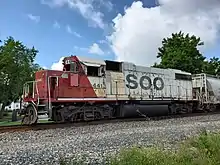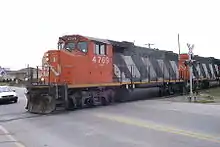| EMD GP38-2 | |||||||||||||||||||||||||||||||||
|---|---|---|---|---|---|---|---|---|---|---|---|---|---|---|---|---|---|---|---|---|---|---|---|---|---|---|---|---|---|---|---|---|---|
 BNSF GP38-2s 2273 and 2778 in Lincoln, Nebraska | |||||||||||||||||||||||||||||||||
| |||||||||||||||||||||||||||||||||
| |||||||||||||||||||||||||||||||||
| |||||||||||||||||||||||||||||||||
| |||||||||||||||||||||||||||||||||

The EMD GP38-2 is an American four-axle diesel-electric locomotive built by General Motors, Electro-Motive Division. Part of the EMD Dash 2 line, the GP38-2 was an upgraded version of the earlier GP38. Power is provided by an EMD 645E 16-cylinder engine, which generates 2,000 horsepower (1.5 MW).[1]
GP38-2W

The GP38-2W is a Canadian variant of the GP38-2. It is easily distinguished by its wide-nose Canadian comfort cab. 51 of these locomotives were produced for the Canadian National Railway during 1973–1974.
Although a W is commonly suffixed to the name, it is actually an addition by enthusiasts to help specify the presence of a CN-spec comfort cab. No locomotives built using CN's design of comfort cab ever featured a W in their designation, as the presence of the cab did not mechanically alter the locomotive. This is reflected by the lack of the "W" in the model designation on the builders' plates of these units.
There are snow shields above the inertial-filter central air intakes behind the cab; the electrical boxes and equipment blower behind the cab also differ in detail from a standard GP38-2. They are otherwise identical.[2]
Original buyers
1,799 examples of this locomotive model were built for American railroads and industrial concerns, 257 for Canadian railroads and industrials, 156 for Mexican railroads and industrials, and 1 export unit for the Saudi Railways Organization. A total of 31 GP38-2s were built with high-short-hoods containing steam generators for passenger service on Mexican railways. In addition, all 257 of Southern Railway's GP38-2s had Southern's "standard" high-short-hoods.[3]
| Railroad | Quantity | Road numbers | Notes |
|---|---|---|---|
| Angelina and Neches River Railroad | 1 | 2000 | |
| The American Rolling Mill Company | 1 | B-84 | |
| Atlanta and West Point Railroad | 2 | 6007–6008 | Family Lines paint. To |
| Atlanta and St. Andrews Bay Railroad | 3 | 508–510 | |
| Belt Railway of Chicago | 6 | 490–495 | |
| Boston and Maine Railroad | 12 | 201–212 | 212 was renumbered 200 as a
bicentennial unit. |
| Burlington Northern Railroad | 37 | 2078–2109, 2150–2154 | 2150-2154 assigned to Fort Worth & Denver. Most passed on to BNSF Railway. |
| Butte, Anaconda and Pacific Railway | 2 | 108–109 | |
| Chicago and North Western Transportation Company | 35 | 4600–4634 | Ordered by Rock Island. To Union Pacific Railroad. |
| Chicago South Shore and South Bend Railroad | 10 | 2000–2009 | |
| Cleveland Electric Illuminating Company | 9 | 100–108 | |
| Clinchfield Railroad | 8 | 6000–6006, 6045 | Family Lines paint. To Seaboard System. |
| Colorado and Wyoming Railway | 2 | 2001–2002 | |
| Conrail | 119 | 8163–8281 | All units were renumbered when divided between CSX Transportation |
| Curtis, Milburn and Eastern Railroad | 4 | 810, 817-819 | |
| Detroit, Toledo and Ironton Railroad | 8 | 221–228 | 228 was renumbered 1776 for
the bicentennial. Renumbered GTW 6221–6228 in 1984–85. |
| Durham and Southern Railway | 4 | 2000–2003 | To Seaboard Coast Line Railroad 556–559. |
| Elgin, Joliet and Eastern Railway | 5 | 700–704 | All to Birmingham and Southern Railroad. 703 re-purchased in the 90s and assigned to Waukegan. |
| Florida East Coast Railway | 11 | 501–511 | |
| Georgia Railroad | 4 | 6009–6010, 6051–6052 | Family Lines paint. To Seaboard System |
| Grand Trunk Western Railroad | 25 | 5812–5836 | |
| Gulf, Mobile and Ohio Railroad | 15 | 740–754 | To Illinois Central Gulf Railroad. |
| Illinois Central Gulf Railroad | 40 | 9600–9639 | |
| Illinois Terminal Railroad | 4 | 2001–2004 | |
| Kansas City Southern Railway | 12 | 4000–4011 | |
| Lehigh Valley Railroad | 12 | 314–325 | To the Delaware & Hudson Railway upon creation of Conrail as 7314–7325. Briefly renumbered to 220-231 during the Guilford ownership of the D&H, upon emergence from Guilford renumbered to 7303–7312. |
| Long Island Rail Road | 28 | 250–277 | 261, 268, 270–271 to New York and Atlantic Railway.
Delivered in Long Island bicentennial scheme. |
| Louisville and Nashville Railroad | 129 | 4050–4144, 6011-6044 | 6011-6044 Family Lines paint. To Seaboard System. |
| Chicago, Milwaukee, St. Paul and Pacific Railroad | 16 | 350–365 | To Soo Line Railroad. |
| Mississippi Export Railroad | 2 | 65–66 | |
| Missouri–Kansas–Texas Railroad | 18 | 304–321 | 319-321 has D\BTo Union Pacific. |
| Missouri Pacific Railroad | 274 | 858–959, 2111–2237, 2290–2334 | To Union Pacific. |
| Penn Central Transportation Company | 223 | 7940–8162 | To Conrail, same numbers. |
| Phelps Dodge | 8 | 1–4, 9, 55, 56, 58 | |
| Pittsburgh and Lake Erie Railroad | 6 | 2051–2056 | |
| Providence and Worcester Railroad | 4 | 2006–2009 | |
| Public Service Company of Indiana | 2 | WG1-WG2 | Lettered for AMAX Coal. |
| Chicago, Rock Island and Pacific Railroad | 68 | 4300–4355, 4368-4379 |
Acquired by GTW, MP and P&LE upon dissolution of Rock Island. |
| San Manuel Arizona Railroad | 2 | 16–17 | |
| Seaboard Coast Line Railroad | 74 | 500–555, 6046–6050, 6053-6065 | 6046–6050,
6053-6065 Family Lines paint. To Seaboard System. |
| Soo Line Railroad | 53 | 790–799, 4410–4452 | 790–799 renumbered 4400–4409
soon after delivery. |
| South East Coal Company | 3 | 3821–3823 | |
| Southern Railway | 257 | 5000–5256 | High-short-hoods. To Norfolk Southern. 23 rebuilt with an Admiral Cab.[note 1][4] 50 to be sold at auction on August 18, 2016. 5076 sold to Northwestern Pacific in 2017. |
| Southern Pacific Transportation Company | 45 | 4800–4844 | |
| St. Louis–San Francisco Railway | 116 | 400–478, 663–699 | To Burlington Northern Railroad. |
| Texas Mexican Railway | 7 | 861–867 | 867 was the last La Grange-built GP38-2 in
May '85. All others built at GMDD London, Ont. |
| Toledo, Peoria and Western Railway | 11 | 2001–2011 | All went to Santa Fe then were divided up, with some going to BNSF after merger and others to KCS. |
| Union Pacific Railroad | 60 | 2000–2059 | |
| Vermont Railway | 2 | 201–202 | |
| Locomotives built by GMD, London, Ontario | |||
| Algoma Central Railway | 6 | 200-205 | |
| Canadian National Railway | 60 | 5500–5559 | 23 renumbered to the 200 series when converted to hump mothers in 1978, these plus one additional renumbered to 7500-7526 (not all #'s used) in 1985. Three more, 7528, 7530, 7532 renumbered in 1990. The balance of these units became 4700–4732 in 1988. Units 4702 and 4728 rebuilt to GP40-3 and repainted to heritage schemes. |
| 51 | 5560–5610 | GP38-2W's. Renumbered 4760–4810 in 1988. 5586 destroyed in the Hinton train collision of 1986. | |
| Canadian Pacific Railway | 115 | 3021–3135 | The 3086-3135 were the last GP38-2's built by GMD, between March and July 1986. |
| Devco Railway | 13 | 216–228 | |
| Ontario Northland Railway | 10 | 1800–1809 | |
| Texas Gulf Sulphur | 2 | 054–055 | |
| Export locomotives built by EMD for other railroads | |||
| Altos Hornos de México | 6 | 141, 145, 157–158, 167-168 | |
| Ferrocarril Chihuahua al Pacífico | 12 | 900-911 | 910 & 911 have high-short-hoods containing steam generators. |
| Ferrocarriles Nacionales de México | 124 | 9200–9299, 9400–9414, 9901-9909 | 9200-9219 & 9901-9909 have high-short-hoods containing steam generators. |
| Ferrocarriles Unidos del Sureste | 14 | 514–521, 528-533 | |
| Saudi Railways Organization | 1 | 2000 | |
| Totals | 2213 | ||
Rebuilds

A number of higher horsepower 40 Series locomotives have been rebuilt into the equivalent of a GP38-2, by removal of the turbocharger and the substitution of twin Roots blowers.
CSX and Norfolk Southern have both started replacing cabs on the aging locomotives. NS still calls them GP38-2 while CSX calls them GP38-3.
Preservation
A relatively small amount of GP38-2s are in preservation, with all being ex-Southern, and all operating on tourist lines.
- Colebrookdale Railroad #5128, built as a Southern subsidiary GSF locomotive, is in a patched NS scheme and is operating excursions on the line.
- Southern Railway #5000, the first GP38-2 ever built, is preserved in operating condition, and sometimes operates excursion trains at the Tennessee Valley Railroad Museum. It was traded from Progress Rail with Norfolk Southern #5033 in 2017.
- Tennessee Valley Railroad Museum #5044, built as a Southern subsidiary C of G locomotive, is in black with ‘TVRM’ logos and the front and rear end. It is expected to operate excursion trains on the Hiwassee River Railroad in the near future.
- Tennessee Valley Railroad Museum #5109, painted in the museum's black and red scheme with yellow striping, is preserved and is operating excursions on the Hiwassee River Railroad.
See also
References
- ↑ Pinkepank, Jerry A. (1973). The Second Diesel Spotter's Guide. Milwaukee, Wisconsin: Kalmbach Publishing. ISBN 978-0-89024-026-7.
- ↑ Foster, Gerald (1996). A Field Guide to Trains of North America. Houghton Mifflin Field Guides. pp. 74–75. ISBN 0-395-70112-0.
- ↑ Marre, Louis A. & Pinkepank, Jerry A. (1989). The Contemporary Diesel Spotter's Guide. Waukesha, WI: Kalmbach Books. ISBN 0-89024-088-4. LCCN 88083625. OCLC 19959644.
- ↑ "What is an Admiral Cab?". altoonaworks.info. L.R. Myers. Retrieved 19 February 2022.
- Thompson, David, EMD GP38-2 and GP38-2W Original Owners.
- The Family Lines Rail System: Condensed List of Locomotives. 1 February 1982.
Notes
- ↑ The Admiral Cab was designed by Norfolk Southern for narrow-nose and low-hood cabs that retains the look of a standard EMD cab, the exceptions being sharper angles, angled center windows, raised numberboard section, under-floor air conditioning, and the nose being made of one inch thick steel instead of the quarter inch steel of the original EMD cab.